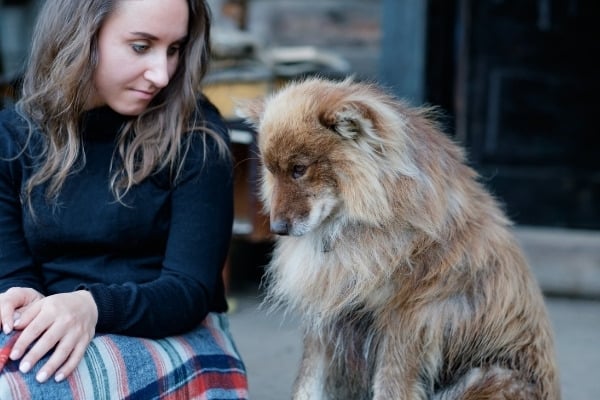
Every dog parent has gone through this at some point – you arrive home and find chewed slippers, shoes, pillows, or worse, couch cushions and your dog sitting in the corner, seemingly remorseful.
Though many dog parents assume that dogs know when they have done wrong, do dogs ever truly try to apologize? How?
How do dogs say sorry? Dogs express remorse and try to apologize with physical signs such as hanging their heads and tucking their tail between the legs. This is a submissive expression inherited from their wolf ancestors, often accompanied by dropped ears, wide eyes, or rubbing their face against their paw.
There is a lot to know about this apologetic behavior in dogs, which reveals the nature of communication in dogs’ eyes.
As you read through the following, you’ll discover if dogs really do know how to apologize or if they are simply reacting to your reaction.
Dogs and Remorse: What To Understand
Dogs are super smart, and they can copy behaviors and understand emotions very well, although not like humans do.
They can learn from the way we react to certain things or behaviors, and understanding our reactions can elicit responses that show in the dog’s body language, eyes, and expressions.
Do Dogs Feel Remorse?
There is plenty of evidence that animals can feel what scientists call primary emotions, like happiness and fear.
However, there is extremely little evidence about them feeling secondary emotions such as pride, jealousy, or guilt.
Secondary emotions, like remorse, require a level of cognitive sophistication, especially when it comes to self-consciousness or self-awareness, which is not likely to exist in non-human animals.
With that said, dogs can display behaviors associated with guilt, although that’s not enough evidence that they have the emotional capacity to experience true remorse.
Dogs learn through observation and training about what is and isn’t acceptable behavior.
Once they understand the boundaries you’ve set for them, crossing or breaking those boundaries, in most cases, will automatically initiate a guilt response from them as they anticipate your reaction.
In short, dogs can “act guilty” as a result of learned association – for instance, chewing a shoe (or any other stimulus) and the impending punishment.
Can Dogs Really Apologize?
Dogs are social animals that crave harmonious relationships within the group. Being neglected or isolated is painful for them.
When you reprimand them for being naughty, dogs will strike a pose, seemingly saying, “I was wrong. I’m sorry. Can we be friends again?” It is your dog’s version of apologizing.
How Do Dogs Apologize? Signs Your Dog Is Trying To Say Sorry
Although dogs don’t truly understand the concept of being sorry, they do understand when you are displeased or angry at what they did, and they will respond accordingly.
That is their attempt to maintain their position in the “pack” and remain in your good graces.
With that said, dogs have a number of ways to apologize for their actions, and they can show these without being told that they’ve been naughty.
Bowing Their Heads
One of dogs’ non-verbal acknowledgments of guilt is bowing their heads and dipping their ears.
Most often, they will also have their tail curved between the hind legs as they tentatively approach you.
Whimpering
In many cases, some dogs will get into your personal space, rub up against your leg, and even add a soft, repeated whimper to emphasize their guilt and reinforce their need for you to forgive them.
Licking
Some dogs say sorry by nuzzling into your neck and licking you. Generally, they are trying to give you as much attention as possible until you give in and forgive them.

How Do Dogs Say Sorry to Other Dogs?
How dogs say sorry to other dogs is simple – by expressive submissive signs, such as cowering, hunched posture, flattened ears, and tucked tail.
Do Dogs Understand Your Apologies?
Whether dogs understand what you mean when you say, “I’m sorry,” remains somewhat of a mystery. They do undoubtedly understand when your anger dissipates though.
The important thing is to reconnect with your dog and ensure him that you’re not angry any more.
Will My Dog Forgive Me for Hitting Him?
While it’s unsure if dogs can forgive you in the sense that humans forgive, what’s certain is that dogs don’t hold a grudge if you hit them once, but remember that they can learn from your responses.
So, if a dog changes his behavior after you hit him, it’s more likely that he’s scared that you will do it again. This is something he is not likely to forget any time soon.
Will My Dog Forgive Me for Yelling at Him?
While your dog may not necessarily forgive you immediately for yelling at him, he will soon simply let go of what happened.
Dogs live in the moment, and before the feelings of guilt rush through your system, your dog may have already moved on, especially if you show him affection afterward.
How To Apologize to Your Dog
Occasionally, dogs can feel terrified when you hurt or yell at them in the heat of the moment. In that case, you can apologize to them in a way that they can understand.
- Soothe your dog by speaking to him gently. If he hides in a corner and avoids you, you can try calling or talking to him from a safe distance. Once he feels comfortable, he will come closer or allow you to come closer.
- Dogs understand your calm and welcoming attitude more than your verbal apology. Your time and praise are the greatest way to apologize to your dog.
Related Questions:
Do Dogs Feel Bad After They Bite You?
In general, dogs won’t feel bad or guilty after they bite you unless it was purely an accident.
Occasionally, they may cower and show signs of guilt, not because they really feel guilty but because of a learned response.
Do Dogs Feel Empathy?
Many dogs show empathy, especially toward their owners. It’s because they can understand and pick up emotions and even distinguish between positive and negative feelings.
For instance, dogs can display empathetic behavior like trying to comfort you when you cry.
Conclusion
Dogs can look sorry and guilty if they know they’ve been naughty – puppy-dog eyes, a tucked tail, and a sad-looking face are common occurrences.
However, their reaction is likely not due to actually feeling remorse as much as it’s a learned understanding of your response to their behavior.




